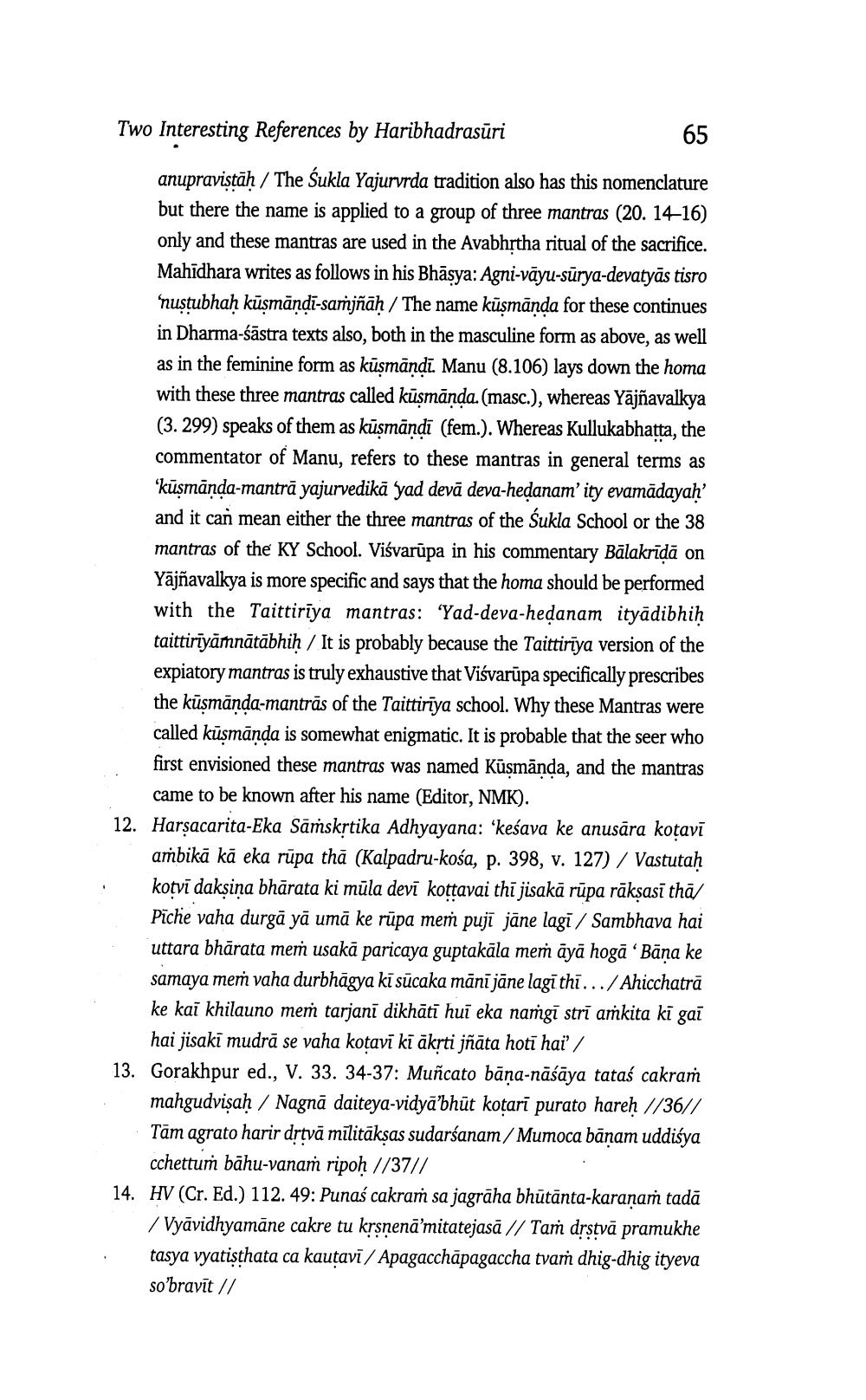________________
Two Interesting References by Haribhadrasūri
65
anupravistāḥ / The Sukla Yajurvrda tradition also has this nomenclature but there the name is applied to a group of three mantras (20. 14-16) only and these mantras are used in the Avabhrtha ritual of the sacrifice. Mahīdhara writes as follows in his Bhāsya: Agni-vāyu-sūrya-devatyās tisro 'nustubhaḥ kūsmāndi-samjñāḥ / The name kūsmānda for these continues in Dharma-śāstra texts also, both in the masculine form as above, as well as in the feminine form as kūşmāndī. Manu (8.106) lays down the homa with these three mantras called kūsmānda. (masc.), whereas Yājñavalkya (3. 299) speaks of them as kūşmāndī (fem.). Whereas Kullukabhatta, the commentator of Manu, refers to these mantras in general terms as ‘kūşmānda-mantrā yajurvedikā yad devā deva-hedanam' ity evamādayaḥ and it can mean either the three mantras of the Sukla School or the 38 mantras of the KY School. Viśvarūpa in his commentary Bālakrīdā on Yājñavalkya is more specific and says that the homa should be performed with the Taittiriya mantras: 'Yad-deva-hedanam ityädibhih taittiriyamnātābhih / It is probably because the Taittiriya version of the expiatory mantras is truly exhaustive that Viśvarūpa specifically prescribes the kūşmānda-mantrās of the Taittirīya school. Why these Mantras were called kūsmānda is somewhat enigmatic. It is probable that the seer who first envisioned these mantras was named Kūsmānda, and the mantras
came to be known after his name (Editor, NMK). 12. Harşacarita-Eka Sāṁskrtika Adhyayana: ‘keśava ke anusāra koțavī
ambikā kā eka rūpa thā (Kalpadru-kośa, p. 398, v. 127) / Vastutaḥ kotvī daksina bhārata ki mūla devī kottavai thī jisakā rūpa rākṣasī thā/ Piche vaha durgā yā umā ke rüpa mem puji jāne lagi / Sambhava hai uttara bhārata meṁ usakā paricaya guptakāla mem āyā hogā ' Bāņa ke samaya mem vaha durbhāgya kī sūcaka mānī jāne lagi thi.../Ahicchatrā ke kai khilauno meṁ tarjanī dikhāti huī eka naṁgī strī aṁkita ki gai
hai jisaki mudrā se vaha kotavi kī akrti jñāta hoti hai' / 13. Gorakhpur ed., V. 33. 34-37: Muñcato bāņa-nāśāya tataś cakram
mahgudvişaḥ / Nagnā daiteya-vidyā’bhūt koțarī purato hareḥ //36// Tām agrato harir drtvā mīlitākṣas sudarśanam / Mumoca bānam uddiśya
cchettum bāhu-vanaṁ ripoḥ//37// 14. HV (Cr. Ed.) 112. 49: Punas cakram sa jagrāha bhūtānta-karaṇam tadā
/ Vyāvidhyamāne cakre tu krsnenā’mitatejasā // Tam drstvā pramukhe tasya vyatisthata ca kautavī / Apagacchāpagaccha tvaṁ dhig-dhig ityeva so'bravīt //
1/3711




